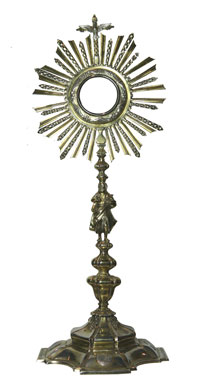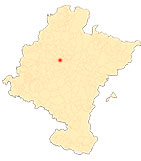Treasure of San Fermín
By Ignacio Miguéliz Valcarlos
Custody
Of Mexican origin, it is a gilded silver monstrance, which is articulated by means of an octagonal base of profile mixtilinear, in which straight sides alternate with others formed by large concave recesses, with a flat flange and two tapering convex bodies. The shaft has an inverted periform knot, followed by two spheroid bodies, on which sits the figure of Saint John the Baptist. Ostensory with a circular virile surrounded by a burst of alternating chamfered and checkered rays. The richness of the piece is achieved through the interplay of architectural volumes of the different bodies that compose it, with a beautiful interplay of curves and counter-curves, limiting the decoration to eight longitudinal concave grooves that run along the piece from the base to the shaft, and to the bunches of vines that are arranged on the base and the convex moulding of the virile. This ornamentation is completed by four medallions cast in silver in the same colour, located on the base and inscribed with the figures of the Evangelists, as well as the image of Saint John the Baptist located on the shaft. Saint John is depicted holding the mystical lamb in his left hand, while pointing to it with his right, and not, as is customary, with his arms stretched out towards the sky, simulating the holding of the monstrance. He wears a camel-skin tunic and a cloak that crosses over his chest. The replacement of the pole by a figure in the monstrance was to be a recurring theme in Mexican workshops during the 18th century, the most common images being those of Saint Michael, Saint John the Baptist and the Immaculate Conception, all of them exalting the Eucharist.
Although it lacks markings, we know its Mexican origin thanks both to its stylistic ascription and to the registration placed on the flange of the base. This monstrance was given by Captain Don Juan Martin de Astiz y Garriz for the church of his place of Gazolaz in the Kingdom of Navarre and was made in the city of Mexico in the year 1757. Thanks to this we know that this monstrance was originally destined for the parish of Gazólaz, where we can see it recorded in the parish inventories up to 1815, and in 1854 there is an entry indicating the purchase of a new bronze monstrance, which would probably replace the lost one studied here. However, we do not know from which status this monstrance left Gazólaz and how it arrived at the chapel of San Fermín, although it should probably be related to the seizure and sale of ecclesiastical jewellery during the Carlist wars. In these sales, pieces in good condition were allowed to be bought either by private individuals or by other parishes, so this monstrance was probably bought by someone who later donated it to the chapel of San Fermín.
-
ANDUEZA UNANUA, P., La arquitectura señorial de Pamplona en el siglo XVIII. Familia, urbanismo y ciudad, Pamplona, Government of Navarre, 2004.
-
ARBETETA MIRA, L., "Cadena y cruz pectoral del tesoro de San Fermín", in ARRAIZA FRAUCA, J., San Fermín patrono, Pamplona, Pamplona City Council, 1989.
-
ARRAIZA FRAUCA, J., San Fermín. El santo, la devoción, la fiesta, Pamplona, Pamplona City Council, 2002.
-
GARCÍA GAINZA, M. C., and others, Catalog Monumental de Navarra. V***. Merindad de Pamplona, Pamplona, Government of Navarre-Archbishopric of Pamplona-University of Navarre, 1997.
-
HEREDIA MORENO, M.C., "Ejemplos de mecenazgo indiano en la capilla de San Fermín de Pamplona", in yearbook de programs of study Americanos, Tomo XLVI, 1989.
-
HEREDIA MORENO, M.C., "Bandejas y jarras del tesoro de San Fermín", in GARCÍA GAINZA, M.C., and FERNÁNDEZ GRACIA, R., (coords.), Juan de Goyeneche y el triunfo de los navarros en la monarquía hispánica del siglo XVIII, Pamplona, Fundación Caja Navarra, 2005.
-
HEREDIA MORENO, M. C., ORBE SIVATTE, M., and ORBE SIVATTE, A., Arte hispanoamericano en Navarra. Plata, pintura y escultura, Pamplona, Government of Navarre, 1992.
-
MIGUÉLIZ VALCARLOS, I., "El tesoro de San Fermín: Donación de alhajas al Santo a lo largo del siglo XVIII", in Promoción y Mecenazgo del Arte en Navarra. Cuadernos de la Chair de Patrimonio y Arte Navarro, nº 2, Pamplona, Chair de Patrimonio y Arte Navarro, 2007.
-
MIGUÉLIZ VALCARLOS, I., "Sacras con los patronos de Navarra y Pamplona", in FERNÁNDEZ GRACIA, R. (coord.), Pamplona y San Cernín 1611-2011. IV Centenary of the city's vow, Pamplona, 2011.
-
MOLINS MUGUETA, J.L., Capilla de San Fermín en la iglesia de San Lorenzo de Pamplona, Pamplona, Diputación Foral de Navarra, 1974.
-
MOLINS MUGUETA, J.L., "La mitra y báculo dieciochescos de San Fermín", in Diario de Navarra. Extraordinary of San Fermín, Pamplona, 1984.
-
MOLINS MUGUETA, J.L., "Mitra y báculo de San Fermín", in MORALES, A. J., Filipinas, puerta de Oriente: de Legazpi a Malaspina, Barcelona, SEACEX, 2003.
-
MOLINS MUGUETA, J.L., "Mitra y báculo del tesoro de San Fermín", in GARCÍA GAINZA, M. C., and FERNÁNDEZ GRACIA, R., (coords.), Juan de Goyeneche y el triunfo de los navarros en la monarquía hispánica del siglo XVIII, Pamplona, Fundación Caja Navarra, 2005.
-
ORBE SIVATTE, A., Platería del reino de Navarra en el siglo del Renacimiento, Pamplona, Government of Navarre, 2000.
-
ORBE SIVATTE, M., Platería en el taller de Pamplona en los siglos del barroco, Pamplona, Government of Navarre, 2008.












